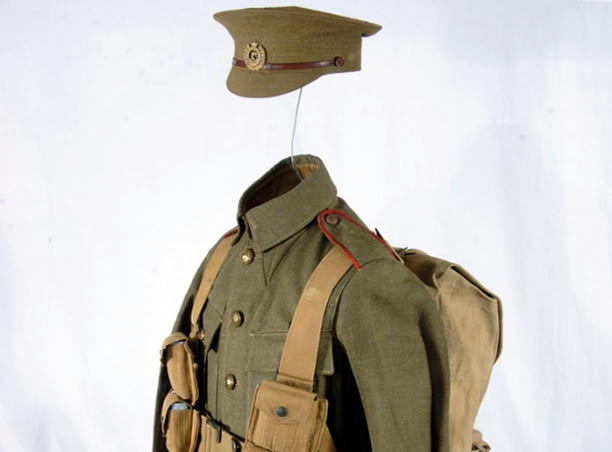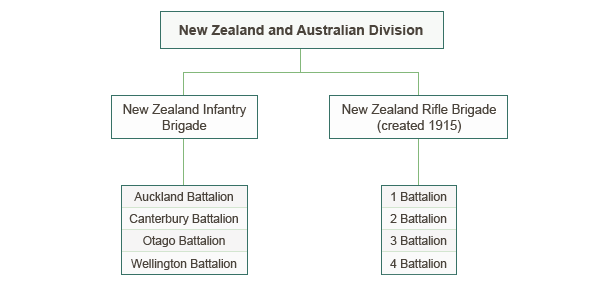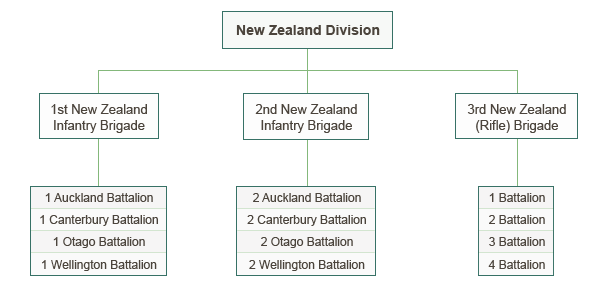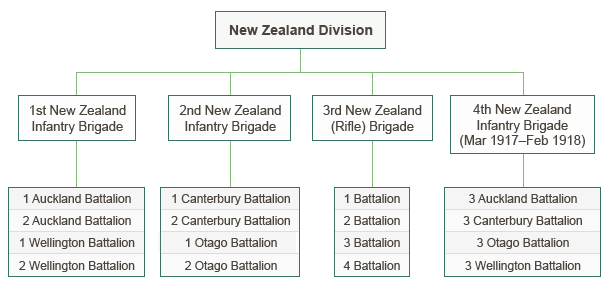
The infantry, soldiers who fought on foot, were the main fighting force of every army during the First World War. The infantry engaged the enemy in close-quarters combat with weapons such as rifles and bayonets in order to capture territory.
Most of the other units worked to support infantry attacks, which were the key to most First World War battles on land. The infantry formed the backbone of the New Zealand Expeditionary Force (NZEF), and made up more than half of all the New Zealand forces at any given moment.
At the start of the war the NZEF had a single infantry brigade of some 4000 men. New Zealand’s four military districts each contributed a quarter of the men for this brigade, which comprised Auckland, Wellington, Canterbury and Otago battalions of around 1000 men each. The New Zealand infantry brigade served in the Gallipoli campaign between April and December 1915. On Gallipoli the New Zealand infantry were tasked with attacking Turkish trenches, usually over steep and exposed ground, and defending their own trenches from attacks.
A second infantry brigade, the New Zealand Rifle Brigade, was established in 1915 during the Gallipoli campaign. Unlike the original brigade, the Rifle Brigade drew recruits from across the country, so it numbered its battalions rather than named them after specific regions. Despatched to Egypt in late 1915, it arrived too late to serve at Gallipoli. Two battalions fought in the Senussi Campaign in western Egypt.
New Zealand infantry, August 1914–March 1916

The New Zealand forces were reorganised in Egypt in early 1916, when a full New Zealand Division was formed. The original infantry brigade was renamed 1st New Zealand Infantry Brigade, and a 2nd New Zealand Infantry Brigade was created. The second brigade’s structure mirrored that of the first, with four regional battalions of 1000 men apiece. The battalions’ order of seniority was: Auckland, Canterbury, Otago, and Wellington.
The New Zealand Rifle Brigade was renamed the 3rd New Zealand (Rifle) Brigade, and the New Zealand infantry now numbered more than 12,000 men.
New Zealand infantry, March–December 1916

The New Zealand Division, which included all New Zealand’s infantry units, sailed for the Western Front in April 1916. From then until early 1918 the infantry spent most of its time in the trenches, where it defended its positions and attacked the enemy in trench raids. It also participated in the major Somme, Messines and Passchendaele offensives, which saw it surge out of the trenches in an effort to drive the enemy into retreat. Casualties among the infantry were consequently heavy, with losses exacerbated by the relatively unsophisticated assault tactic of sending men ‘over the top’ in frontal attacks against entrenched enemy positions which had not always been weakened by preliminary artillery barrages.
By 1917, infantry were using new techniques to overcome enemy machine guns and artillery. Improved weapons (mortars, grenades, light machine guns) enabled the development of flexible tactics based around mutually supporting groups of machine gunners and ‘bombers’. Platoons comprising rifle, light machine gun and bombing sections became the smallest tactical units. Battalions received support from machine gun platoons, mortar batteries and artillery. By 1918, an infantry battalion was a specialised unit of riflemen, scouts, machine gunners, bombers and sharpshooters.
A reshuffling of battalions saw the North Island battalions moved into the 1st Brigade and the South Island battalions into the 2nd Brigade. In March 1917 the New Zealand forces established a fourth infantry brigade (a third battalion was raised in each regiment), temporarily pushing total infantry numbers up to around 16,340 men. The fourth brigade was disbanded in February 1918.
New Zealand infantry, January 1917–November 1918

The infantry remained on the Western Front until the Armistice, after which it marched into Germany to form part of the army of occupation in Cologne until March 1919. Battalions and brigades were progressively merged and disbanded during 1919 as demobilisation proceeded.

Community contributions